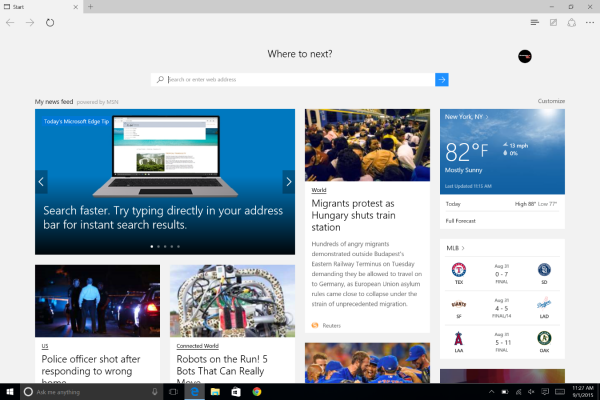Crafting Your Digital Gateway: A Comprehensive Guide on How to Set Homepage(s) in Microsoft Edge Browser

Introduction
Microsoft Edge, the default web browser in Windows 10, offers users a versatile and customizable browsing experience. One fundamental aspect of personalizing your online interactions is setting a homepage or multiple homepages. This comprehensive guide aims to empower users with step-by-step instructions, optimization tips, and troubleshooting insights on how to set homepage(s) in the Microsoft Edge browser. Whether you’re aiming for quick access to your favorite website or creating a curated homepage experience, this guide will assist you in crafting your digital gateway to the internet.
Understanding the Significance of a Custom Homepage
1. Efficient Browsing Routine:
- Setting a custom homepage in Microsoft Edge allows users to streamline their browsing routine. Opening the browser automatically takes you to your preferred starting point on the internet.
2. Quick Access to Favorites:
- A custom homepage provides quick access to your favorite website, ensuring that your most relevant and frequently visited content is just a click away.
3. Personalization and Productivity:
- By setting a homepage tailored to your preferences, you can create a personalized and productive online environment. This is particularly beneficial for users who rely on specific websites for work or information.
Step-by-Step Guide on How to Set Homepage(s) in Microsoft Edge
1. Open Microsoft Edge:
- Launch the Microsoft Edge browser on your Windows 10 computer.
2. Access the Settings Menu:
- Click on the three horizontal dots in the upper-right corner of the browser window to open the menu.
3. Navigate to Settings:
- From the menu, select “Settings” to access the browser’s settings.
4. Locate the On Startup Section:
- In the settings menu, find the “On startup” section. This section determines what happens when you open Microsoft Edge.
5. Select the “Open a Specific Page or Pages” Option:
- Choose the option that says “Open a specific page or pages” under the “On startup” section.
6. Click on “Add a New Page”:
- Click on the “Add a new page” link to add a custom homepage. This could be a website URL or a specific webpage.
7. Enter the Homepage URL:
- In the dialog box that appears, enter the URL of the website or webpage you want as your homepage. You can add multiple homepages by repeating this step.
8. Save Changes:
- After adding your preferred homepage(s), click “Add” and then click “Save” to apply the changes.
9. Close and Relaunch Microsoft Edge:
- Close Microsoft Edge and relaunch it to see your custom homepage(s) in action.
Tips for Optimizing Homepage Settings
1. Categorize Homepages:
- If you have multiple homepages, consider categorizing them based on relevance or use. For example, you might have a set of work-related homepages and another set for leisure.
2. Use a Visual Dashboard:
- Instead of a traditional webpage, consider using a custom image or a personalized dashboard as your homepage. Visual cues can make your browsing experience more engaging.
3. Utilize Browser Extensions:
- Explore browser extensions that enhance the functionality of your homepage. Some extensions allow you to add widgets, news feeds, or to-do lists directly to your homepage.
4. Regularly Update Homepages:
- Periodically review and update your set homepages to ensure they align with your current preferences and needs. Adding or removing homepages can keep your browsing experience fresh.
5. Explore Dynamic Content:
- Some websites support dynamic content on their homepage tiles. Right-click on a homepage tile, select “More,” and choose “Turn live tile on” if available. This can provide real-time updates.
Troubleshooting Common Issues
1. Homepage Not Loading:
- If your homepage is not loading correctly, double-check the URL to ensure it is accurate. If the issue persists, try removing and re-adding the homepage in Microsoft Edge settings.
2. Incorrect URL Entered:
- Ensure that you enter the correct URL when adding a new homepage. Typos or incorrect URLs can prevent the homepage from loading as intended.
3. Browser Updates:
- Ensure that your Microsoft Edge browser is updated to the latest version. Browser updates often include improvements and bug fixes that enhance homepage settings.
4. Clear Browser Cache:
- If you encounter issues with homepage loading, clearing the browser cache can resolve potential conflicts. In the settings menu, navigate to “Privacy, search, and services,” and click on “Choose what to clear” to clear the cache.
Conclusion
Setting homepage(s) in Microsoft Edge is a straightforward yet impactful way to personalize your browsing experience on Windows 10. This comprehensive guide, enriched with step-by-step instructions, optimization tips, and troubleshooting insights, aims to empower users to navigate these settings with confidence. Whether you’re focused on efficiency, quick access to favorites, or creating a curated digital space, let this guide be your companion on the journey to a more tailored and enjoyable browsing experience. As you explore the possibilities of custom homepages in Microsoft Edge, may your digital gateway become a reflection of your preferences, contributing to a seamless and personalized internet journey.




